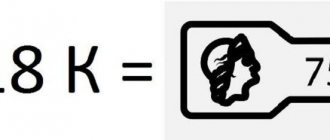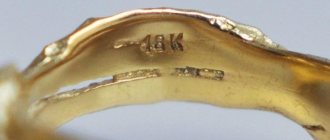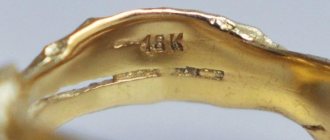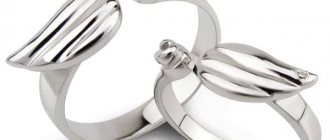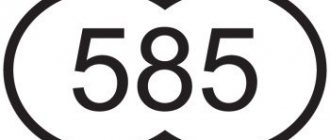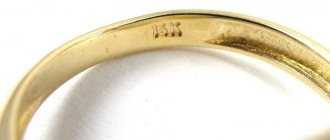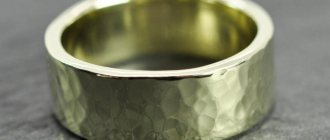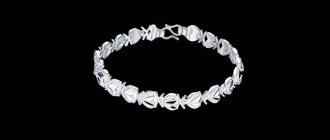Post updated: May 28, 2020
In the Russian Federation they use the metric system, and in Western countries they use the carat system. 24 carat gold is considered the purest, and if you are wondering what standard it corresponds to in the karat system, know that it is 999.
In addition, in different countries they use various designs and forms of marks on the product. The Russian stamp depicts a woman in a kokoshnik; the Ukrainian stamp depicts either the state emblem or a chestnut leaf, next to which the sample number is written.
The quality of the product is reflected by the amount of pure gold contained in the alloy from which the jewelry is made (since jewelry is not made from pure precious metal). Such a system is established and protected by government regulations and standards. For this purpose, the types of imprints and stamps have been standardized, the numbers on which indicate the sample number.
What is carat
The name of the metal comes from the Latin word aurum - “light of the rising sun.” The term “carat” is used to indicate the weight of jewelry. The generally accepted abbreviation is ct. The weight of one carat is 200 mg. In England, this unit is used to determine the purity of gold. The higher the carat number, the fewer impurities in the metal. Depending on the alloy, metal is divided into 7 classes.
Origin of the word
The word "carat" comes from the Arabic qīrāt, the Latin carat, which means "carob pods". The plant was valued by jewelers in eastern countries. The fruits were distinguished by a constant shape, and the ancient masters called them “curatonia”.
The Egyptians, Romans, and Greeks were looking for a standard for comparing precious stones. This is how the comparison went with the seed, which weighed almost 200 mg.
Features of British carat gold
It is not an element of a strict system of weights and measures. Therefore, initially the gold carat, which is also called the British carat, was called non-systemic. Its name itself comes from the carob tree Ceratonia siliqua. This tree is widespread in Mediterranean countries. In ancient times, local residents noticed one interesting feature of the fruits of this evergreen plant: all its pods were always the same size and weight. People began to use this unique feature as a weight standard. During the heyday of the Roman Empire, the dry fruits of this tree were officially included in the system of measures. One unit corresponded to 0.19 grams, and this unit was called “siliqua”. Carat is the Greek name for siliqua, which spread throughout the world much later.
And here lies the main point that confuses many people. The carat, which traces its origins back to the Mediterranean wood, is used to measure the weight of diamonds, while the gold carat is not based on weight. Unlike its metric counterpart, which has a precise weight, the imperial gold alloy quality unit is a dimensionless value. It indicates the number of parts of pure gold in a particular product.
The maximum is 24 parts of the mass of the object. For example, it weighs 100 grams and is made of pure gold. In this case, to understand how many grams are in 1 carat of gold, you need to divide one hundred grams by 24. Thus, it turns out that one carat in a hundred-gram gold item can be equated to 4.1 grams, and depending on the weight of the item and its purity alloy this figure will change.
Due to the variability of British carat weights, no one uses weight as a guide. Take into account how many parts of pure gold are contained in the product.
So, if the 24-karat indicator indicates that the object consists of 100% precious metal, then in a 12-karat piece of jewelry it already accounts for 50%, and the remaining 50% are various ligatures. To find out the percentage of pure precious metal in a piece of jewelry, focus on one carat, which corresponds to 4.2%. For example, if you have an 18 carat piece of jewelry, simply multiply 18 by the percentage of one carat (4.2%) and you will get just over 75%.
How to determine carat content
There are two systems used to indicate the purity of gold:
- carat;
- metric.
Carat determines the percentage of pure Au. The system is common in Great Britain, America, Switzerland and a number of other European countries. Among the British, 9-carat gold is popular, in the United States - 10, 14-18, India - 22, and the Chinese prefer 24 carats.
The purest alloy is 24 carats. To calculate the proportion of additives, you need to subtract the carat from 24. 9K contains 9 parts of gold and 15 additives.
Sample purity
Samples can be converted to the karat system. The purest standard used in jewelry is 958. It corresponds to 23 carats. Impurities here are necessary to change the properties of the material towards greater strength. 22 carats is 917, also quite pure. 18 carat or 750 standard is a traditional type of alloy that allows you to create a balanced alloy with other metals. It is this numerical indicator that can be called optimal. 14 carat - 585 gold. It is very common both in Russia and in Europe. Due to the large percentage of impurities, it can obtain an original shade, and also has sufficient hardness for various jewelry manipulations - twisting, stretching, straightening to the state of a sheet. 10 carats is 416 fine, and just over 40% pure gold. This is the lowest metal purity standard in the United States. In Russia, 375 fineness of 9 carats is also acceptable. In the East, the 8-carat marking, containing 33.3% gold, is also used. To convert gold in carats and convert it to the metric system, the table below may be useful:
How to convert to the metric system and sample correspondence table
In Russia and the CIS countries, the metric type of notation is common. It refers to the amount of Au without impurities per 1000 particles. A 750 sample product contains 750 parts of pure metal and 250 particles of impurities. That is, each kilogram of this sample will contain 750 g of gold and 250 g of alloys.
You can convert the carat system to the metric system using the formula:
24*Y:1000, where Y is the fineness of gold in the metric system.
For example, 24*375:1000 = 9. 375 gold in the metric system is equal to 9K.
Convert the metric measurement system to carat using the formula:
1000*X:24, where X is the carat measurement system.
1000*9:24=375.
How to correlate the metric and carat systems is indicated in the table.
| Metric system | 999 | 958 | 750 | 585 | 583 | 500 | 375 |
| Carat system | 24 | 23 | 18 | 14 | 14 | 12 | 9 |
Terms of Service
|
|
Legislative regulation
Russia provides for strict regulation and quality control of metal. In Decree of the Russian Federation No. 372 of April 5, 1999, the Ministry of Finance is assigned the responsibility to control the certification of precious metals and products made from them. Certification is required:
- Cut gemstones. They are tested at retail.
- Diamonds without jewelry processing.
- Unique nuggets.
- Minerals and recyclable materials with admixtures of precious metals.
Resolution of the Russian Federation No. 394 of May 6, 2016 “On testing, analysis and hallmarking of jewelry and other products made of precious metals” establishes:
- types of products subject to the branding procedure;
- procedure for providing the brand;
- labeling methods;
- reasons for refusal;
- sample setting algorithm;
- restrictions on the use of solders.
A mark with a mark indicates the purity, that is, the purity of the precious metal. They are divided:
- 375 – the percentage of pure gold is 38.5%;
- 500 – half consists of impurities;
- 583 – 58.3% gold;
- 585 – 58.5% Au;
- 750 – 25% base metal;
- 958 – 0.42% impurities;
- 999 – the purest gold, 24 carats.
The most common markings are 585 and 750. They are distinguished by increased strength and hardness.
What kind of sample is this?
24 carat gold is 999 fine. Why not 100%? There is no pure metal in nature. Refining, that is, the procedure for removing impurities, leaves only 0.01 percent of additives in the gold ore. 24 carats are considered elite.
A little about this test
The state gold reserve is formed from 24 carat metal. In Rus' it was called red for its red color when heated. To obtain the purest metal, the ore is subjected to an expensive refining process.
Composition and properties
The metal consists of 99.9% pure gold. According to State Standard No. 30649-99, additives can be lead, iron, antimony, bismuth, copper, and silver.
The amount of additives should not exceed 1/10 percent. By agreement with the Assay Office, palladium and platinum can be used as additives.
Au 24 carat has a number of features:
- Temperature changes and high humidity are not dangerous for the precious metal. Au 24 carat is ductile and corrosion resistant. The surface is not covered with plaque under any conditions.
- A metal of the highest standard, like any chemical element, is exposed to the aggressive effects of chlorine, a mixture of nitric and hydrochloric acids of high concentration.
- The product turns out fragile and soft. Jewelry is easily deformed, so jewelers rarely use 24-karat gold.
- It is used extremely rarely as a material for the jewelry industry due to its high cost.
Strength
24 carat gold has a strength of 120 MPa. It is classified as a material subject to deformation. Expensive jewelry breaks under physical stress.
Expert opinion
Vsevolod Kozlovsky
6 years in jewelry making. Knows everything about samples and can identify a fake in 12 seconds
The hardness is 18 HB. The metal is soft, marks remain on the surface if you run a knife across it. Melting point – 1063 degrees Celsius. The color of the molten metal is greenish. Aurum boils at 2947 °C.
Pure 24-karat gold is malleable and ductile. One gram can be rolled into foil with an area of 1 square. m or make 2.5 m of wire.
Alloy shade chart
The color of jewelry alloys depends on the type of impurities. 24 carats is a pure metal, there are practically no additives in it. Therefore, the color remains constant - bright yellow. The table shows the color change of Au with various impurities.
| Share of gold, % | Proportion of impurities, % | Main composition of impurities | Alloy color |
| 99,9 | 0,1 | Silver, palladium, platinum, copper | Yellow |
| 96,0 | 4 | Copper | Yellow |
| Copper | Red | ||
| 75,0 | 25,0 | Copper, silver, nickel; copper, silver | Yellow |
| Nickel, zinc, copper; palladium, silver, copper | White | ||
| 50,0–58,0 | 42–50 | Copper, silver | red |
| Silver, copper | Yellow | ||
| Silver, copper | Green | ||
| Nickel, silver, zinc, copper | White | ||
| 37,5 | 62,5 | Copper, silver | Red |
| Silver, palladium, copper | Pink |
Brand
Precious products are subject to mandatory branding. This procedure is entrusted to the Assay Supervision Inspectorate established by the state. The shape of the stamp is a blade, consisting of 3 blocks:
- inspection code;
- assay mark;
- sample designation.
The Russian print depicts the profile of a woman's head in a kokoshnik, turned to the right. The form of the brand was introduced in 1994.
Each 24k gold piece contains a seal secured with white thread. Unsealed products are not allowed for sale.
How much does 1 gram of gold of this standard cost?
The highest standard is more expensive than other alloys. The cost is determined by the amount of gold reserves and the dollar exchange rate. According to the Central Bank of the Russian Federation, the average price of a gram of 24 carats today is shown in the graph:
| Price 999 standard according to the Central Bank | Market value of the sample today | Scrap price | Price in jewelry |
How much does 1 gram of gold of this standard cost?
Gold has long become a hard currency; it is used to carry out payment transactions and evaluate the official reserve assets of states (gold and foreign exchange reserves). To calculate the bank value, you need to multiply 0.585 by the figure established by the Central Bank, but the price in stores and pawn shops may differ significantly.
| Price 999 standard according to the Central Bank | Market value of the sample today | Scrap price | Price in jewelry |
| 3857 rub. | 3853 rub. | 3468 rub. | 4050 rub. |
Difference between 14 and 24 carats
The most important difference between the metals of these samples is the content of impurities. For 24 carats, according to GOST No. 30649-99, the ligature does not exceed 0.1%, for 14K – 41–41.5%. This means that the highest sample consists of almost 100 percent Au, and 585 - only 58.5%.
Cleanliness, hardness and durability
24 carat gold is highly chemically resistant to aggressive environments, but its mechanical properties leave much to be desired. Products made from it are soft, easily deformed, the surface is scratched and dull.
A product made of 585-grade metal does not lose its shine over time, and gains hardness and strength thanks to the addition of copper.
Color and price
Color 24K – bright yellow. The authenticity of coins and chervonets was checked using heating. If the color was red, then the metal was clean. As the gold cools, it acquires its primary color. Due to the small amount of impurities, the color does not change.
14K metal has a wider color palette. A high content of copper gives a red tint, silver and copper - yellow, silver - green.
The price of samples differs significantly: the average price of a gram of 24 carats is 2500 rubles, 14K is 1600 rubles.
How and where the price of gold is formed: the concept of the troy ounce and price fixing
The cost is determined taking into account various factors. The main thing is the rate of the Central Bank of the Russian Federation, which, in turn, depends on the work of the London Stock Exchange. Two daily fixing indicators are used as determining ones: morning, evening. Moreover, the price of this metal is set with the direct participation of the 5 largest banks in the world. Based on the information provided, it is possible to regulate prices.
Fixing is a procedure performed to determine a compromise in the issue of gold pricing.
It presupposes the need to achieve market equilibrium between buyers and sellers. Moreover, prices can be in American dollars and pounds. The troy ounce is used as a reference unit when determining the cost of a precious metal taking into account its mass. It corresponds to the value of 31.1034768 g. This is a way to determine the amount of precious metal.
What to consider when purchasing products
Commemorative badges, medals, precious coins, and bank gold bars are made from gold of the highest standard.
Au 24 carat is a heavy metal. The weight of the products is at least 10 grams. Accordingly, the cost of a small product will be high. Pure gold jewelry is rare. Mostly, jewelers make massive wedding rings: thanks to their volume, they will retain their shape.
The surface of the product is easy to scratch, so the jewelry should be stored carefully.
Scope of gold, 999 purity
Due to the fact that pure metal is very soft, it is rarely used to create jewelry. Most often, massive rings are created, weighing about 10 grams. Such bulkiness is a necessary measure, otherwise the rings will be easy to deform, even when putting them on. Pure metal has gained great popularity in the investment field. Bullions weighing from 1 kilogram are an excellent deposit, the value of which is constantly growing. Most of the countries' gold and foreign exchange savings are represented by .999 gold bars. The deposits of wealthy people are also very often represented by gold bars. In ancient times, rings, earrings, bracelets and others were created from pure gold. It was also used to cover the domes of churches, which protected them from corrosion. With the development of metalworking, alloys with alloys began to appear, and pure metal began to fade into the background.
Interesting fact. The greatest demand for products made from 24 carat metal is observed in Arab countries. The need to carefully monitor products does not stop residents of this region from buying jewelry. The main thing is the high purity of the alloy and high-quality jewelry work.
How to distinguish gold from gilding
Counterfeiting of jewelry and high-quality items is common. The Assay Office claims that 15% of all products are counterfeited annually. Basically, products made of silver, copper, brass, coated with a thin layer of 24 carat gold are passed off as noble metal. To avoid falling into the trap of scammers, use these tips:
- Before visiting a store or pawnshop, stock up on a magnifying glass. It will help you better see the mark on the product. This aurum must be marked with the Assay Supervision Inspectorate indicating the sample. Gilded items do not have a hallmark or receive a base metal marker.
- Pay attention to the edges of the jewelry: gilding is a thin gold coating on an item made of any metal. It tends to wear off over time. If the color is uneven, then the item is not completely gold.
- Stock up on a magnet. 24 carat metal is diamagnetic and will not attract. But the impurities may include alloys that are attracted by a magnet.
- Each ingot must have a certificate and passport.
You can have your metal checked without leaving the store. The main thing is not to damage precious products!
Next, we suggest watching an interesting video about how you can check gold for authenticity at home:
How to recognize a fake
First of all, the stigma is studied. If the sample corresponds to (999), it is assumed that the alloy is real. The original is also determined by other parameters:
- weight – other jewelry is lighter;
- bright yellow metal;
- there is shine;
- if you press, the precious metal will be pliable, but you should behave carefully, because it can be severely deformed (due to its low density);
- the price of the precious alloy is much higher than the rest;
- metal certificates are checked;
- To distinguish gilding from precious metal, you should examine the surface: a fake may have an uneven tone.
Interesting: They check the quality of high-grade metal (999) using a magnet. This will only work if the alloy does not contain iron group components.

